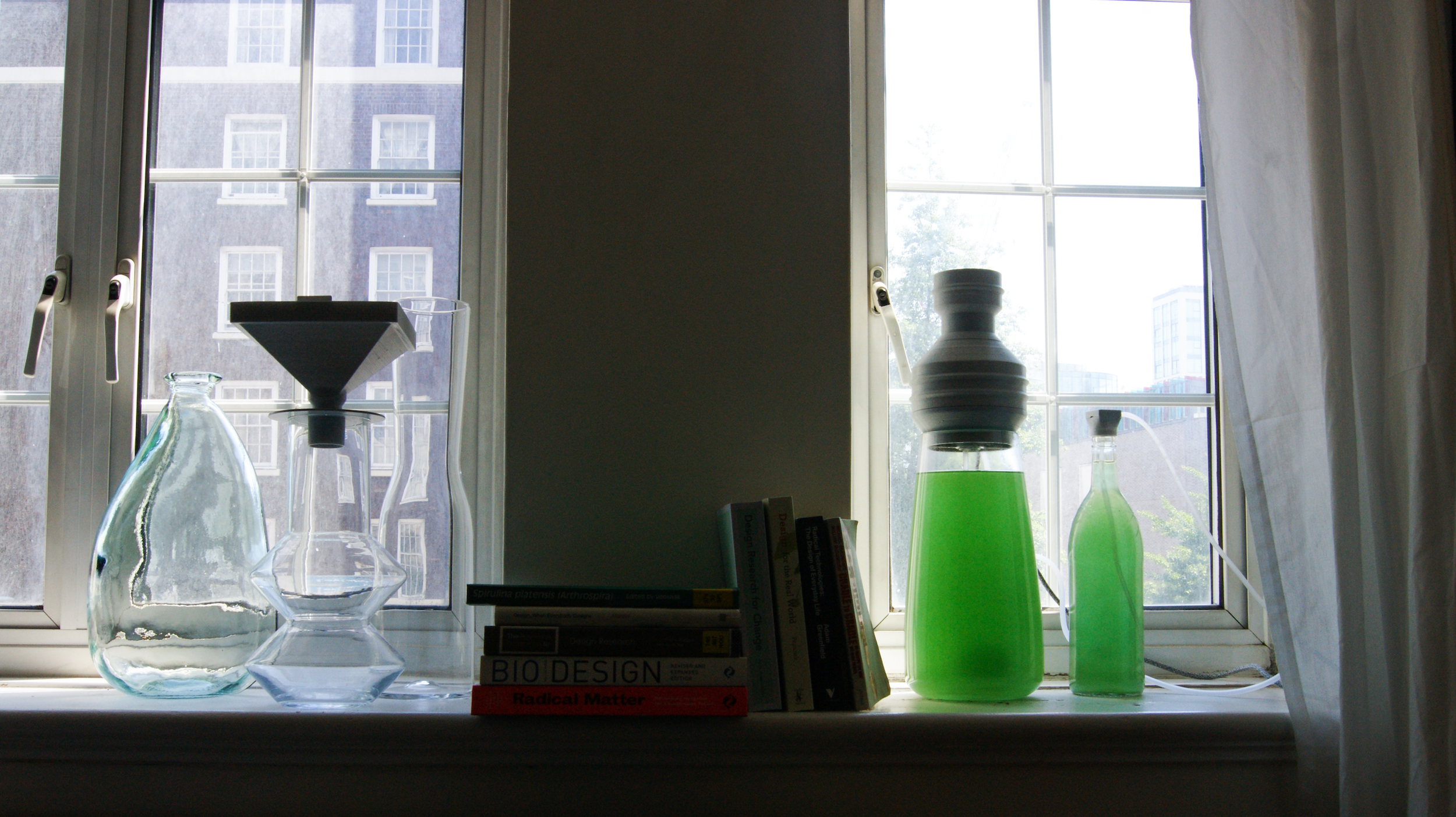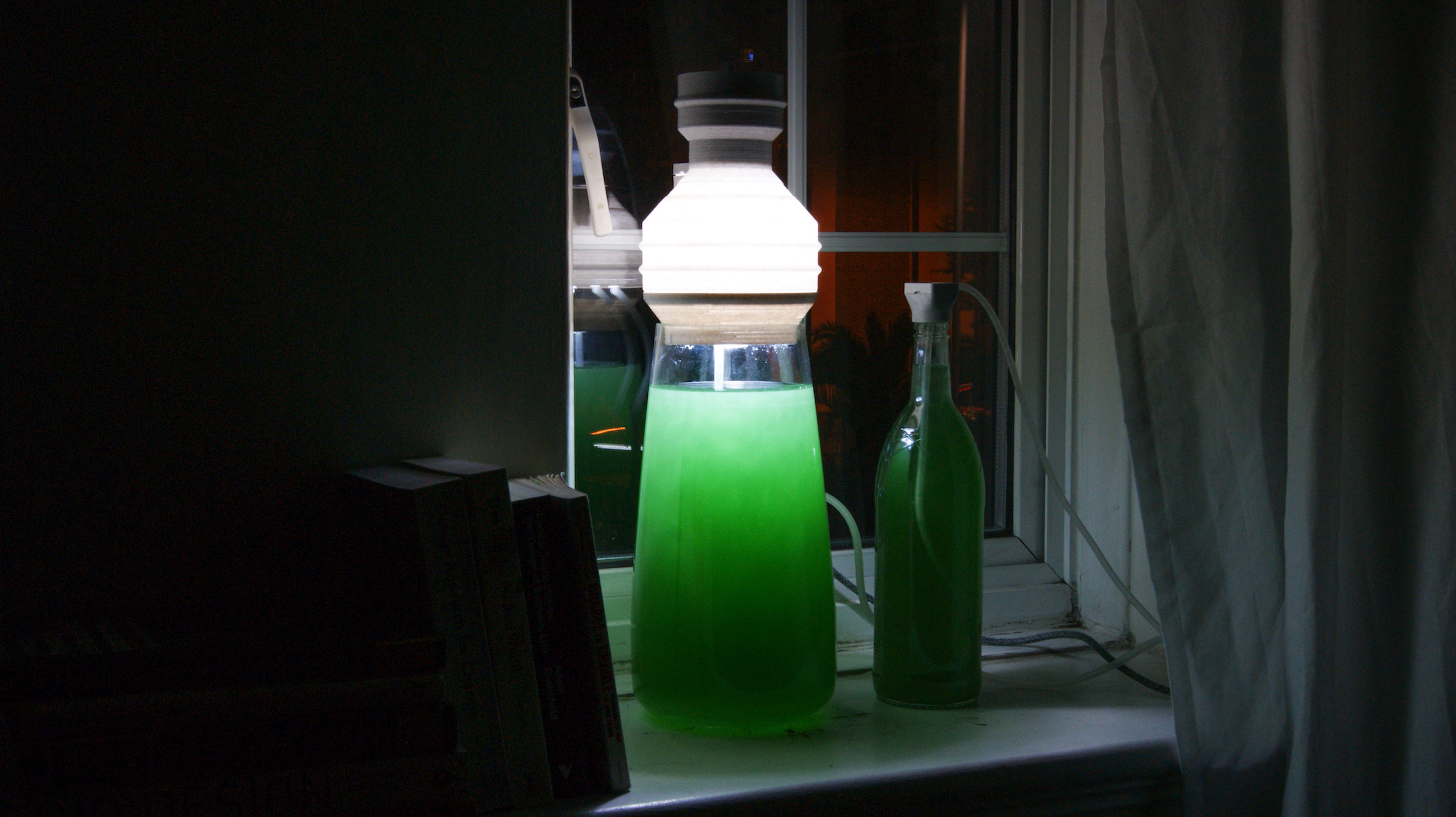Spirulina Society

Useful information
- Team members
- Anya Muangkote
- Country
- United Kingdom
- Keywords
- Sustainability Wellbeing Empowerment Open Source Community Local Post-carbon Knowledge Sharing Digital Distribution Agency Self-sufficiency Spirulina Cultivation Urban Farming Nourishment Superfood Regenerative Accessible Cost-effective
Short Description
Spirulina Society provides open-source tools and knowledge for domestic Spirulina cultivation.
Detailed Description
We live in times of climate crisis where our ecosystems are endangered. With food production causing extensive greenhouse gases, deforestation and water shortage. As a collective, what if we rethink the way we produce and consume our food?
Spirulina, a blue-green alga, is the most ideal food for humankind. It is a plant-based source of complete protein. Spirulina can easily be grown indoors and only requires a small amount of water and space. By performing photosynthesis, it can be harvested daily.
Spirulina Society aims to normalise the sustainable and efficient cultivation system for an urban lifestyle—where people produce their own food, maintain their wellbeing, cut down the waste and reduce the ecological footprint.
It provides 3D models of the cultivation tools for people to download and connect with their local makerspaces/manufacturers. The 3D printed collection consists of lids and harvesting funnel that can be fitted with locally and readily available containers.
Project Details
- Does your design take social and cultural challenges and human wellbeing into consideration?
This project looks at food production and climate crisis, in terms of how the food system as a whole contributed to 26-37% of total greenhouse gas emissions and it is projected to be increased by 30-40% in 30 years time.
As mentioned earlier, growing Spirulina only requires a small amount of water and space. Water consumption and land use in Spirulina production are 100-220 times less than meat production. If grown in domestic space, there is no arable land required and the carbon footprint is very low because this cuts out logistics fundamentally.
Apart from saving resources, reducing carbon emissions and waste, growing Spirulina at home yields more benefits. Thanks to its cost-effectiveness, meaning it is affordable and accessible to almost everyone. You can control what goes into the cultivation system and avoid toxic chemicals or heavy metals contamination that can typically be found in commercial farms. Since Spirulina is nutrient-dense, consuming Spirulina daily could help prevent cancer, lower blood pressure, reduce cholesterol, and many more; according to experts.
In addition, eating nutritious food, in this pandemic era, is vital given what is currently happening with the lack of food in supermarkets. Domestic Spirulina cultivation could enhance better physical and mental health because it can tackle malnutrition, increase productivity and boost the immune system which means more virus-resistant bodies are present.
On the whole, Spirulina cultivation is truly ideal for the environment, empowerment, and wellbeing.
- Does your design support sustainable production, embodying circular or regenerative design practices?
In order to support a circular economy, the design is limited to the use of single material (PLA) and one method of production (3D printing) mainly for the sustainable aspects. Firstly, additive manufacturing produces less waste and consumes less energy than traditional ones. Secondly, using PLA is much more sustainable than its counterparts that are derived from fossil fuels (ABS, PETG, and TPU) since it is renewable, bio-based, recyclable and compostable under specific conditions. Moreover, there is no toxic fume released when printed.
One of the design criteria for 3D models is to use the least material possible; the structures of the models were designed to be printed without supporting materials which means there is almost no waste in the production process. Additionally, the adaptability of the design encourages the ease of use with local or repurposed containers.
- Does your design use principles of distribution and open source?
Spirulina Society provides 3D models of the cultivation tools for people to download digitally and connect physically with their local makerspaces and manufacturers around the globe. This project promotes local and on-demand production by shifting away from the mass-production model and using the distributed model where it focuses on the movement of data and the use of local material supply chains.
The sizing of the design is based on the standard sizes of small desktop 3D printers to endorse inclusivity. Principally, the design supports customisation with the user’s choice of containers, materials, and filaments (colours/textures) based on their preferences and location.
Although the project hasn’t been made public yet, all the tools are fully functional, proven by my experiment of growing, harvesting, and consuming in my own bedroom for over a period of 5 months. For quality testing, I plan to send out files to my friends who own desktop 3D printers at home next week. I’m currently working on the instructions and once it’s finished this project will be ready for public participation (aiming to be published before the end of July). For future development, I aim to make my design more customised and personalised by providing more various sizes, shapes, and incorporating parametric design to involve the user even more in the creative process.
- Does your design promote awareness of responsible design and consumption?
This project focuses on knowledge sharing and creating an inclusive and empowering community through design. It encourages people to source globally available materials locally and guides them towards a sustainable lifestyle by introducing the principles of local production and consumption. The cultivation tools themselves are the enabler for people to start producing their own food and rethink the food production system/process in a fundamental way.
The method of communication is focused on the basic understanding of the ‘whys’ before the ‘hows’. It is highlighted on the website that if the users fail to understand the purposes of responsible design and consumption, then it is not recommended to purchase any equipment or download the files in any case as this project intends to help people create less waste, not more.
Images


